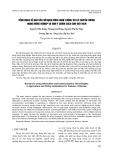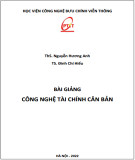
Quản lý tài nguyên & Môi trường
TẠP CHÍ KHOA HỌC VÀ CÔNG NGHỆ LÂM NGHIỆP TẬP 13, SỐ 6 (2024) 75
Tài nguyên thực vật rừng ngập mặn tại Khu Dự trữ Sinh quyển Thế giới
Rừng ngập mặn Cần Giờ: thực trạng và giải pháp bảo tồn
Huỳnh Đức Hoàn1*, Bùi Nguyễn Thế Kiệt1, Viên Ngọc Nam2
1Ban Quản lý rừng phòng hộ Cần Giờ, TP. Hồ Chí Minh
2Trường Đại học Nông Lâm TP. Hồ Chí Minh
Mangrove plant resource in Can Gio Mangrove Biosphere Reserve:
current situation and conservation solution
Huynh Duc Hoan1*, Bui Nguyen The Kiet1, Vien Ngoc Nam2
1Can Gio Protection Forest Management Board, Ho Chi Minh City
2Nong Lam University - Ho Chi Minh City
*Corresponding authors: huynhduchoanpy@gmail.com
https://doi.org/10.55250/jo.vnuf.13.6.2024.075-084
Thông tin chung:
Ngày nhận bài: 06/09/2024
Ngày phản biện: 08/10/2024
Ngày quyết định đăng: 14/11/2024
Từ khóa:
Cần Giờ, đa dạng thực vật,
hệ sinh thái, quần xã.
Keywords:
Can Gio, community,
ecosystem, plant diversity.
TÓM TẮT
Sau hơn 45 năm phục hồi, quản lý, bảo vệ và phát triển hệ sinh thái rừng
ngập mặn Cần Giờ, đa dạng sinh vật rừng ngập mặn luôn có chiều hướng gia
tăng, trong đó thành phần các loài cây ngập mặn thực sự được duy trì và
bảo vệ tốt. Qua kết quả nghiên cứu từ 200 ô đo đếm (diện tích 100 m2) từ dự
án “Tổ chức quản lý bền vững Rừng ngập mặn Cần Giờ tầm nhìn đến năm
2025” do Ban Quản lý rừng phòng hộ Cần Giờ tổ chức thực hiện. Kết quả
nghiên cứu ghi nhận có 24/35 loài ngập mặn thực sự. Đước đôi và Mắm
trắng là 02 loài ưu thế trong cấu trức rừng ngập mặn tự nhiên tại Cần Giờ.
Các loài cây quý hiếm như: Cóc đỏ, Quao nước, Sú cong, Cui biển, Côi và các
loài Vẹt cần được chú trọng trong công tác bảo tồn và phát triển loài. Trên
cơ sở nhận diện các khó khăn trong công tác bảo tồn đa dạng sinh học, nhóm
tác giả đưa ra một số đề xuất liên quan, trong đó cần chú trọng thực hiện
những nghiên cứu tổng hợp và toàn diện về đa dạng thành phần thực vật
trong Khu Dự trữ sinh quyển Cần Giờ, duy trì tính đa dạng thành phần loài
thông qua đẩy mạnh công tác trồng rừng với đa dạng thành phần loài cây
trồng nhằm phát huy chức năng của hệ sinh thái rừng ngập mặn Cần Giờ
ngày càng bền vững hơn.
ABSTRACT
After more than 45 years of restoration, management, protection, and
development of the Can Gio mangrove ecosystem, the biodiversity of
mangrove forests has always tended to increase, in the composition of
mangrove species is truly maintained and well-protected. The research
results from 200 measurement plots (each plot has an area of 100 m2) from
the project "Organization of sustainable management of Can Gio mangrove
forests with a vision to 2025" organized by the Can Gio Protection Forest
Management Board. The research results recorded 24/35 mangrove species.
Rhizophora apiculata and Avicennia alba are the two dominant species in the
structure of natural mangrove forests in Can Gio. Rare species such as:
Lumnitzera littorea, Dolichandrone spathacea, Aegiceras corniculatum,
Heritiera littoralis, Aegiceras floridum, Scyphiphora hydrophylacea and
Bruguiera sp... need attention conservation and development. Based on the
identification of difficulties in biodiversity conservation, we proposed many
related proposals, including the need to focus on conducting comprehensive
and comprehensive studies on plant diversity in the Can Gio Biosphere
Reserve, maintaining species diversity through promoting afforestation with
diverse plant species to promote the function of the Can Gio mangrove
ecosystem to be more and more sustainable.

























